Understanding Core Advantages of E-advertising
How e-advertising offers precise targeting, real-time tracking, cost efficiency, and higher engagement, boosting your brand's visibility and conversions.

How have our lives, jobs, and shopping been affected by the internet? In my experience as a client and business owner, internet advertisements are becoming the most efficient means of reaching today's market. Traditional advertising techniques have begun to wane.
Having worked in the marketing field for many years, I've experienced how e-advertising has changed the scene and given companies more intelligent ways to connect with their target market. After adopting digital marketing, clients who had been on the fence about it saw a marked increase in website traffic, brand awareness, and overall revenue.
By 2024, e-advertising in India is expected to increase at a 31% CAGR to reach ₹51,110 crore. Businesses are switching from traditional to digital marketing, with e-commerce and FMCG leading the way, and this is what is causing their rapid growth. (SocialSamosa)
E-advertising produces tangible outcomes; it's not simply a catchphrase. In my experience, companies who use digital ads can simply track performance, make strategy adjustments, and realize considerable growth by adapting to the changing needs of their target audience. They also benefit from real-time data.
The Evolution of Digital Advertising
I have observed a noticeable transition over the years from traditional forms of advertising, such as print and television, to digital forms, where firms interact with consumers online. This shift has improved consumer engagement and increased conversions by altering the way brands interact.
Digital advertising's ascent has revolutionized marketing by providing companies with extensive data on customer behavior. Digital advertising is more efficient and economical than old techniques because firms can precisely target audiences using sophisticated digital marketing tools.
Reputable websites that provide real-time tracking and optimization capabilities, such as Facebook, Instagram, and Google, control the digital advertising space. Thanks to them, companies may rapidly modify their efforts and achieve quantifiable results. Improved engagement across industries and rising digital ad spending are reported by Ipsos (Ipsos).
Why is E-advertising Better for Today’s Businesses?
Businesses may interact with their audiences more personally thanks to e-advertising. Companies may develop communications that resonate with potential customers and increase engagement and sales by focusing on specific demographics and interests.
E-advertising also offers instant feedback, which helps companies track the effectiveness of their campaigns and make necessary changes. By ensuring that marketing initiatives stay current and productive, this adaptability enables businesses to make the most of their resources and accomplish their objectives.
What is E-advertising?
E-advertising, or digital advertising, is the process of promoting goods and services using websites, search engines, and social media. Using digital marketing tools to create tailored, interesting messages for particular groups, helps firms reach their customers more precisely and economically.
The unique quality of e-advertising is its real-time performance tracking. Companies can instantly make modifications by monitoring indicators such as click-through rates and conversions. This flexibility showcases the advantages of e-advertising, and in today's rapidly evolving internet environment, when paired with digital marketing analytics, it gives a substantial edge.
Types of E-advertising
Through interesting content, social media advertising enables businesses to connect with specific audiences. It creates connections, encourages brand loyalty, and increases revenue on user-friendly platforms.
2. Search Engine Advertising
Businesses can reach out to consumers actively looking for products by using search engine advertising. It is crucial for drawing in potential clients since it increases visibility and traffic.
3. Display Advertising
Websites with display advertising utilize attention-grabbing images to get visitors in. It's a fantastic method to increase click-through rates and brand recognition.
Customers receive personalized communications directly in their inboxes thanks to email marketing. Tailored advertising and exclusive deals foster connections, keep consumers informed about new items, and increase conversions.
5. Content Marketing
To engage audiences, content marketing disseminates insightful information. Businesses can gain credibility and develop trust with prospective clients by producing informative articles, films, or infographics.
6. Native Advertising
Content with native advertising feels less like an advertisement since it fits in naturally. This strategy improves user experience by drawing attention and offering useful information.
7. Mobile Advertising
Mobile advertising sends personalized messages to users on their devices. Businesses can connect where their customers spend their time by reaching audiences on the go.
8. Programmatic Advertising
Programmatic advertising uses data-driven tactics to automate the acquisition and placement of ads. It guarantees that companies effectively target the right audience by optimizing ads in real-time.

Importance of E-advertising in the Current Marketing Environment
-
Targeted Reach: E-advertising enables companies to use digital marketing tools to precisely target their audience, ensuring that ads are seen by the appropriate individuals and generating better conversion rates and higher levels of engagement.
-
Cost Efficiency: Businesses can use cost-effective advertising through e-advertising, whereby they pay only for user interaction with their adverts through models such as pay-per-click.
-
Real-Time Performance Tracking: Real-time insights provided by e-advertising enable companies to monitor important performance indicators promptly and modify their digital marketing tactics for optimal efficiency.
-
Increased Engagement: Through engaging interactions, e-advertising facilitates two-way communication between businesses and consumers, particularly on social media, thereby fostering deeper ties and the development of trust.
-
Scalability: Using digital marketing techniques to reach both local and worldwide audiences, e-advertising allows firms to expand at their own pace.
Core Advantages of E-advertising
1. Precise Targeting and Personalization
The capability of e-advertising to carefully manage who sees your adverts is one of its biggest advantages. Digital advertising enables more effective targeting of particular demographics than traditional advertising, which reaches a wider audience.
For example, you can target people who are interested in health and wellness if you are marketing workout equipment. By using a customized strategy, you can make sure that the people who are actually interested in your message are hearing it, which can increase sales and highlight the advantages of e-advertising.
Why It’s a Game-Changer:
The ability to target precisely makes budget allocation more intelligent. By increasing your return on investment, digital marketing helps you avoid wasting money on advertising that is seen by unlikely consumers.
2. Cost Efficiency and Flexibility
Another key advantage of e-advertising is its cost-effectiveness compared to traditional methods. Pay-per-click (PPC) advertising is one approach that ensures real interaction because you only have to pay when someone clicks on your advertisement.
E-advertising offers scalability in addition to being more cost-effective. Starting small, you can assess the effectiveness of your ads, and raise your spending as you see a return on investment. Both small and large firms profit from this flexibility.
Why It’s a Game-Changer:
Businesses of all sizes may compete successfully with e-advertising. The advantages of e-advertising include the fact that you don't need a large initial budget and may easily modify your expenditure in real time based on outcomes.

3. Real-Time Tracking and Analytics
Imagine if a TV advertisement were to air without any information regarding the number of viewers, interested parties, or sales. That doubt is removed with e-advertising. From ad impressions to clicks and conversions, you can keep an eye on everything in real time.
You can get detailed campaign metrics from platforms like Facebook Ads and Google Ads. The advantages of e-advertising are highlighted by the ability to assess what works and what doesn't, allowing you to make quick adjustments to improve results.
Why It’s a Game-Changer:
E-advertising provides you with real-time insights regarding the effectiveness of your ads. This feature enables fast adjustments, optimizing your campaigns to increase efficacy and reduce waste. It's an important tool for companies trying to succeed in the cutthroat economy of today.
4. Higher Engagement and Interactivity
Conventional advertising is frequently biased. There's little opportunity for involvement when you view a billboard or TV commercial. E-advertising, on the other hand, promotes interaction in real-time. Users can like, share, and comment on social media adverts, which greatly enhances user engagement.
For example, video advertisements on sites like YouTube draw attention and enable users to click over to your website. The advantages of e-advertising are further illustrated by some advertisements that incorporate interactive elements like surveys, quizzes, and quick discounts.
Why It’s a Game-Changer:
Engagement from the audience is greatly increased via interactivity. By fostering user interaction with your brand, you can forge closer bonds with consumers and raise the possibility that viewers will become devoted patrons. In today's marketing environment, e-advertising stands out thanks to its dynamic approach.
5. Wide Reach with Diverse Platforms
The internet offers plenty of opportunities, and e-advertising gives you access to multiple venues for audience engagement. There are countless options, ranging from social media platforms like Facebook to search engines like Google.
Effective audience targeting is possible with several platforms. The advantages of e-advertising are highlighted by the fact that younger groups could be more active on Instagram and TikTok, while professionals frequently interact on LinkedIn.
Why It’s a Game-Changer:
Depending on your goals, e-advertising allows you to target specific markets or a worldwide audience. Because of this adaptability, advertisements may be customized for every platform, increasing the efficacy and reach of marketing campaigns.
Businesses looking to prosper in a competitive climate must adopt a digital strategy. Effective client connections can be facilitated by the useful tools offered by e-advertising. Precise targeting and real-time analytics, which boost audience engagement, are advantages of e-advertising. Businesses may develop individualized experiences that appeal to customers by leveraging a variety of platforms. The advantages of e-advertising boost overall performance and profitability while also improving client relations for firms navigating this ever-changing sector. Long-term success and the development of solid client connections depend on a commitment to contemporary marketing strategies.




























































